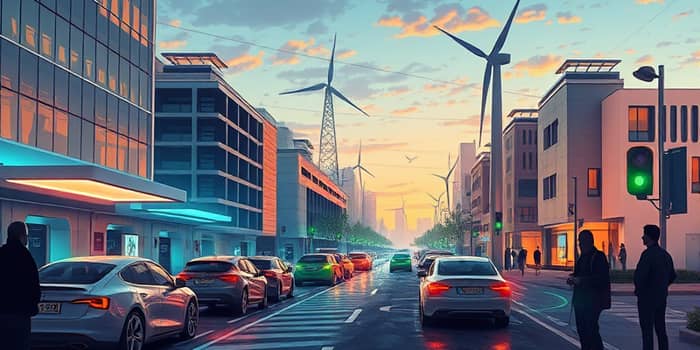In early 2025, the electric vehicles (EV) sector stands at a crossroads, fueled by revolutionary changes in technology, policy, and consumer sentiment. This article delves deep into the transformative power of EV adoption, uncovering how investments, regional dynamics, and sustainability goals intertwine. Whether you are a seasoned investor, an automaker, or a curious consumer, understanding these trends will equip you to navigate the rapidly evolving landscape and seize emerging opportunities.
The global vehicle electrification market has witnessed unprecedented expansion. Valued at $91.6 billion in 2024, it is on track to surpass $205 billion by 2034, growing at a projected CAGR of 8.4%. Driving this surge are consumer demand for greener transport and aggressive automaker strategies. Sales momentum remains robust, with 2024 registering 16.7 million EV units, up from 13.9 million in 2023. These figures highlight the industry’s steady climb towards a cleaner future.
Yet, beyond raw numbers lies a rich tapestry of technological breakthroughs, policy shifts, and investor enthusiasm. From breakthroughs in battery chemistry to the expansion of charging networks, each innovation chips away at previous barriers. In parallel, governments worldwide deploy incentives and subsidies to catalyze adoption. Together, these forces paint a compelling picture of an industry poised for dramatic transformation over the coming decade.
Global Growth Trajectories
The EV revolution is more than a sales phenomenon; it’s an economic and environmental imperative. Forecasts suggest that by 2025, electrified vehicles could account for up to 25% of new car purchases, a milestone that underscores shifting consumer priorities. As the world strives for net-zero emissions, EVs will play a pivotal role in displacing millions of barrels of oil per day and reducing carbon footprints.
- 16.7 million EV units sold globally in 2024, representing a 20% market share.
- Projected 25% electrified vehicle share of new vehicle purchases in 2025.
- Control of oil displacement goals: EVs need to replace 8.2 Mb/d by 2030 to meet Net Zero targets.
- 1.3 million EVs sold in January 2025, marking an 18% year-on-year increase.
These figures reflect not only growing consumer acceptance but also the success of policy frameworks and industry commitments. However, sustaining this momentum will require addressing critical infrastructure and affordability challenges, ensuring no market is left behind.
Investment and Financial Trends
As EV sales continue to climb, financial markets have taken notice. Exchange-traded funds (ETFs) focused on EV technology and battery supply chains saw record inflows in early 2025. Investors are broadening their scope beyond premium manufacturers, targeting scalable mass-market models and upstream suppliers. Automakers, in turn, have ramped spending on R&D and production capacity, aiming to capture a wider consumer base.
Capital allocation trends reveal a notable shift: from early adopters of luxury EVs towards mainstream consumer affordability and practical solutions. Legacy brands such as Toyota, Ford, and GM are pouring resources into hybrid and plug-in hybrid offerings, bridging the gap between internal combustion engines and full electrics. This strategy not only addresses range anxiety but also aligns with varying consumer price sensitivities across regions.
Private equity players and venture capital firms are also increasing stakes in battery startups focusing on solid-state technology and rapid charging. These bets reflect an industry-wide belief in the disruptive potential of next-generation batteries to further diminish costs and enhance performance, ultimately driving broader adoption.
Regional Insights and Divergent Pathways
Each region presents unique dynamics. China’s leadership is undisputed, backed by robust manufacturing ecosystems and aggressive domestic policies. Europe’s patchwork of incentives and stricter emissions standards continues to spur growth, particularly in countries offering purchase subsidies and urban low-emission zones. In the United States, uneven infrastructure and state-by-state regulations create both opportunities and challenges, with markets like California and New York leading the transition.
Technological Innovations Accelerating Change
The pace of technological innovation is staggering. Breakthroughs in battery energy density and safety promise longer ranges with shorter charging times. Ultra-fast charging networks are expanding across highways and urban centers, mitigating traditional range anxiety and empowering road trips. Meanwhile, advances in manufacturing techniques, such as gigacasting and automated cell assembly, are driving down costs, enabling more affordable EV models.
Additionally, integration with renewable energy sources, smart grid participation, and vehicle-to-grid (V2G) technology are redefining the EV’s role in the energy ecosystem. Cars can now act as mobile energy storage units, feeding electricity back to the grid during peak demand, thus enhancing grid resilience and unlocking new revenue streams for owners.
Policy and Regulatory Environment
Government actions remain a critical catalyst for EV adoption. The US federal tax credit of up to $7,500 continues to shape consumer decisions, though new sourcing requirements for battery materials may limit eligibility. European nations balance direct purchase incentives with CO2 emission penalties for automakers, creating a dual-pronged approach. China’s extensive subsidies, coupled with local mandates, sustain its manufacturing dominance.
However, policy uncertainties linger. Political shifts could alter incentive structures, while debates on tariffs for battery imports and raw materials introduce additional complexity. For investors and automakers, staying agile in response to evolving regulations is paramount to maintaining competitive advantage.
Consumer Dynamics and Market Challenges
Consumer attitudes are evolving rapidly. Whereas early adopters prized cutting-edge features and performance, mainstream buyers emphasize affordable total cost of ownership and charging reliability. Franchise network expansion, home charging solutions, and innovative leasing models address these concerns. Automakers are responding with subscription services and comprehensive service packages to simplify the ownership experience.
- Range anxiety remains a psychological barrier for many potential buyers.
- Charging infrastructure gaps persist in rural and suburban areas.
- High upfront costs push cost-sensitive consumers toward hybrids.
- Second-hand EV market is still nascent, limiting affordability options.
Addressing these challenges requires coordinated efforts across stakeholders: utilities must invest in grid upgrades, governments should offer targeted grants for rural infrastructure, and manufacturers need to optimize battery recycling to lower lifecycle costs.
Towards a Sustainable Future
Electric vehicles are driving a profound shift, not only transforming how we travel but reshaping economies, energy systems, and investment priorities. By 2030, achieving 65% EV adoption under Net Zero pathways demands sustained innovation, policy support, and consumer education. Investors can harness these trends by focusing on diversified portfolios spanning automakers, battery innovators, and charging infrastructure providers.
Manufacturers must strike a balance between affordability and innovation, leveraging scale to bring advanced features to broader markets. Meanwhile, policymakers should refine incentives to encourage adoption without fostering market distortions. For consumers, embracing EVs entails more than purchasing a car; it represents participation in a cleaner, smarter transportation ecosystem.
The journey ahead is complex but filled with promise. Through strategic investments, technological breakthroughs, and collaborative policymaking, the industry can overcome barriers and fulfill the vision of an electrified mobility future. Electric vehicles are more than a trend; they are a transformative force, promising economic growth, environmental benefits, and social progress for generations to come.
References
- https://www.coxautoinc.com/market-insights/ev-market-monitor-january-2025/
- https://www.evdesignandmanufacturing.com/news/state-electric-vehicle-industry-2025-beyond/
- https://www.virta.global/blog/the-year-of-the-ev-what-2025-holds-for-electric-vehicles-and-emobility
- https://www.etftrends.com/leveraged-inverse-channel/electric-vehicle-sales-off-strong-start-2025/
- https://evmagazine.com/technology/top-10-2025-trends
- https://www.nasdaq.com/articles/ev-market-forecast-top-trends-evs-2025
- https://www.iea.org/energy-system/transport/electric-vehicles
- https://www.jdpower.com/business/resources/e-vision-intelligence-report-january-2025










